Sonic Adventures (Act 5)
Despite the 1995 launch of 32 bit hardware, the Mega Drive remained commercially viable, and Sega were keen for a further Sonic game for it in time for the Christmas 1996 season. In a somewhat unlikely turn of events, UK studio Traveller’s Tales were hired to produce the game, using the isometric design briefly considered for Sonic 3. The final version of Sonic 3D adopts a somewhat unconventional structure, with the hedgehog having to rescue five birds trapped inside the level’s badniks and lead them to the safety of a warp gate before he can clear the act. The winged creatures shown in concept art for the series had always been dubbed ‘Flicky’, in a homage to the eighties arcade title, but now that game’s mother-hen concept was patched into the gameplay wholesale, with Sonic’s quest being to free the extra-dimensional birds from Robotnik’s clutches. The level structure of the game mirrored earlier titles, with each zone made up of two acts and a boss, with special stages accessible on payment of a fifty-ring tariff.
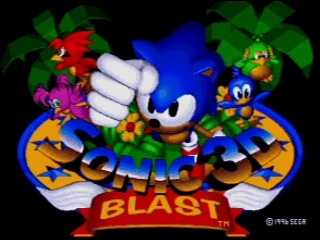 |
Traveller’s Tales’ technical know-how isn’t open to question, but their design work has never quite reached these standards. Sonic 3D is slow and fiddly to play, and feels like an also-ran. There’s a cast-iron way of distinguishing between a full-fledged and serious Sonic game, with imagination and creative intent behind it, from a tie-in knocked out to make a quick buck. Surprisingly, this distinction pays no heed of quality. No one would deny that Sonic & The Secret Rings is a genuine title in the series, although it features some disastrous gameplay mechanics. The key is in the setting of the levels, and the amount of thought that has been put into them. Given that Sonic games are all about moving through interesting places in an interesting way, its essential that the games avoid falling into the traps of either adhering to the generic levels found in a clichéd platform game (fire, ice, etc.) or simply rehashing the archetypal perception of a Sonic title, by opening with a tropical paradise and moving through pinball, flying fortress and the other iterations which featured in Sonic Team’s first three titles. This is best demonstrated by looking at the occasions when the main Team themselves returned to old ideas, as they never fail to add a new spin to the concept. Flying Battery [S&K] is a faster, more high-tech setting than Wing Fortress [Sonic 2]. Emerald Coast [Sonic Adventure] is a much more commercially developed area than the idyllic tropical paradise of Emerald Hill [Sonic 2]. Even when the creative failure of Sonic Heroes was in development, the Team were able to add at least one new level concept, in the form of Hang Castle. Looking at the first 16-bit Sonic platform game not developed by Sonic Team, Sonic CD passes this test, bringing something new to the party, whatever other failings it possesses. Sonic 3D falls back on the already tired old standbys, and so offers little to the player.
Remember the US cartoon series? Sadly, the horror didn’t end with the cancellation of the second version of the show. After the conclusion of SatAM, the same company produced another Sonic cartoon, under the title of ‘Sonic Underground’. I’d originally planned to gloss briefly over this abortion, but consulting the internet has informed me that some people appear to hold it in, if not high esteem, then a level fractionally raised above the ground, obliging me to elaborate further. Essentially, Sonic Underground took the basic concept of the previous series (i.e. Sonic is the leader of a rebellion against the ruling power), and preceded to throw vast amounts of rubbish at it in the hope that some would stick. The concepts blasted out included making the hedgehog a deposed prince (honesty, what is it with the US conception of Sonic and royalty? BEING A REPUBLIC IS ONE OF YOUR FINEST ACHIEVEMENTS!), giving him two siblings (one of which is predictably named ‘Manic’) and the final indignity of having Sonic being the lead singer in a band. (Amusingly, a completely different voice actor was required for the parts of the show when its title character was called upon to sing.) Sonic Underground managed to avoid cancellation for a surprisingly long time, but eventually it received the fate it deserved.
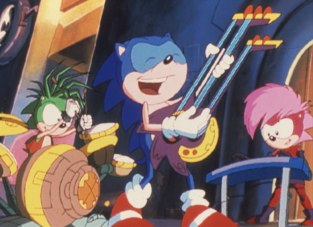 |
Despite the hiring of Traveller’s Tales for Sonic 3D, the US’s Sega Technical Institute were by no means finished with Sonic. Internal experiments with the second title’s engine saw the construction of code for an ‘elastic band’ that would tie Sonic & Tails together, enabling all sorts of slingshot mechanics. The tech demo (these days know as ‘Sonic Crackers’) was greenlit for development as a full-blown Mega Drive game, but its development was anything but smooth. The title was quickly switched to the 32X as a means of propping up the ailing add-on. It soon became obvious that the hardware was beyond help however, and the endorsement of Sonic’s presence was pulled from the game that then recieved the title of Knuckles’ Chaotix. The plot involved Dr Robotnik’s attack on a theme park, which left its defenders imprisoned in a giant claw machine, from which only one of the team can be released at a time via “link ring” technology. Before tacking each act, Knuckles may swap his partner, or even surrender himself in order to allow two of his friends their freedom at once. The cast was drawn from an array of unlikely sources. Vector The Crocodile has been intended for inclusion in Sonic’s first game, but was scrapped from the final version. Resurrected as the leader of Chaotix, he was joined by custom-created characters Epsio The Chameleon and Charmy Bee. Further adding to the numbers was Mighty The Armadillo, fresh from his turn in the Japanese arcade game.
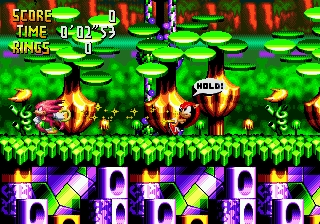 |
The game is essentially made up of five themed zones within the park, each of which is broken down into five acts. In a break with tradition, these levels are tackled in any order, with the next act chosen from another semi-randomising selection machine located in the game’s hub level. The levels themselves are extremely atmospheric, with the flat-out roller coaster Speed Slider a clear inspiration for the 3D Sonic games’ “highway” stages. Boss design is a little weak, but the arrival of Sonic CD’s Metal Sonic for the final area is a nice touch. Although the pastel art direction is a curious choice, the there’s a richness of detail here that goes beyond any other 2D Sonic games, and some areas are remarkably memorable. Sound design is good, with appropriate and striking music. The game is actually much faster than the Mega Drive’s 2D Sonic titles, with the elastic serving as a means of rapid acceleration above and beyond the classic spin dash, and several “throw” moves preventing the supporting character even being stuck behind a part of the scenery. A particular highlight of the game is its special stages. Although not winning any awards for originality, with Sonic 3’s blue spheres added to a hexagonal tube, the 32X’s 3D abilities allowed a much-improved implementation, with the tube often opening out into a true landscape and the implimentation of physics making falling off a real threat. Chatoix was a solid title, but its format appeared to destin it to obscurity, until Sonic Heroes’ need for a bulked-up cast saw the team given an unlikely second chance.
At the time, however, the relative gameplay triumph of Chaotix over the still in-development Sonic 3D appeared to be a decisive factor in the evolution of the franchise. With Sonic Team having departed back to Japan to work on NiGHTS, the obvious place for the core series to continue was now at the STI. SoJ were uninterested in the series, with its western-success largely missed due to Sonic’s middling profile in Japan. Sega of America’s head was not so inattentive, however, and handpicked a team to create a Sonic blockbuster to spearhead the Saturn’s Christmas 1996 line-up, under the title Sonic X-Treme. The game would be a 3D platformer, but in an intriguingly retro definition of the term…
Anyone played Bug?
Just me, then. Bug was released as part of the Saturn’s first wave of software, and seemed to point the way forward for the platforming genre that had proved so popular on 16-bit consoles. Unlike how we think of a 3D adventure title today, however, Bug followed a more limited premise, being basically a 2D platformer, with a twist. Holding “up” on the d-pad no longer caused the character to stare at the sky, but instead walk into the screen along a narrow path, effectively adding a second plane of 2D platforming to the title, instead of a true 3D experience. Oh, it’s easier if I just show you:
 |
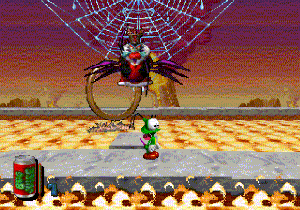 |
Ironically, Sonic made a cameo appearance in one of Bug’s bonus levels, racing against the insect to pick up power-ups before dashing off at speed. It’s something of a tribute to the Sonic 3 sprite that it could be inserted into a next-generation title without looking out of place. As you’ll have gathered, the Bug-but-faster X-Treme never made it to market, for reasons which I’ll explain shortly. What we know of the title is an intriguing mix of fan-pleasing decisions and elements that sound more tentative. The art direction is rather odd, with the checkerboard motif that the Mega Drive applied to its walls taken to its logical conclusion as a subtle texture on the floor. Creatively, Sonic X-Treme has a lot in common with the Archie universe, and the plot outline just feels like the US conception of the character, with a distinguished scientist being targeted by Dr Robotnik, keen to steal his research. The professor calls in Sonic to help in the struggle against the mad scientist, and the hedgehog team up with his young niece while defeating Robotnik. There are a few touches which endear the project to fans- most noticeable the use of the curvy ‘Sonic The Hedgehog’ logo, and an early screenshot showed the inclusion of the Sonic CD version of Metal Sonic as one of the game’s bosses.
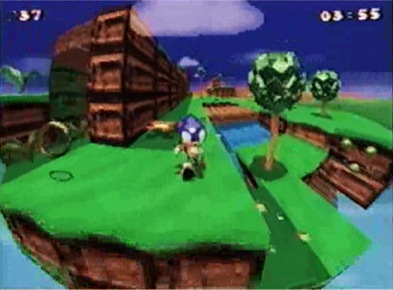 |
When pitched as Sega’s response to Mario 64, the game had a positive showing at E3 1996, with much interest attracted by the numerous gameplay features implemented to overcome Bug’s problems, most noticeably the “Reflex Lens” fisheye perspective which improved the player’s peripheral vision. Other additions feel like more uncomfortable compromises, such as giving Sonic the ability to fire rings at enemies, in an early recognition of the problems involved in depth perception when using the traditional spin attack in a 3D environment. Throughout the summer of 1996, however, rumours about the poor health of the title began to circulate, with all divisions of Sega being keener to talk about Sonic 3D, and the Saturn marketing campaign noticeably focussing on NiGHTS. The inevitable came in October, when it was announced that Sonic’s glorious return was being placed on hold indefinitely. The impression at the time was that X-Treme was cancelled on the orders of Sega Japan, who were unhappy with the project creatively. This is partially true, but the initial loss of momentum was due to internal problems. The production process placed an unprecedented level of stress on the lead programmer for the title, who had written the engine single-handedly, and was living in his office for months before the game had even entered crunch. When the inevitable happened, and he folded under the pressure, it was obvious that the game could not be completed without outside assistance. When interviewed by Sonic Cult, producer Mike Wallis recounted how told Sega US’s CEO what he needed to get the project to market- the NiGHTS game engine. A couple of days later, the complete source code for Sonic Team’s masterpiece duly arrived from Japan, but at this point politics start to play a part, with the data being pulled from the STI after about a week. This is widely believed to be on the orders of Yuji Naka, although given his civility to the X-Treme team when he’d visited the STI earlier in the year, it’s probable that he was possessive of the NiGHTS technology rather than motivated by objections to X-Treme. Whatever the reasoning, Sonic’s 32-bit debut was dead in the water.
Next Time: Sega’s big hope for 1996 cancelled at short notice? Just what were they thinking? Come back next week to see how the company tried to recover from this self-inflicted head inury.
About this entry
- By Julian Hazeldine
- Posted on Sunday, July 12 2009 @ 11:02 pm
- Categorised in Games, Analysis
- Tagged with sonic the hedgehog, Sonic Adventures, Sega
- 3 comments

Where’s the interview?
By Ridley
July 13, 2009 @ 12:35 am
reply / #
Ridley:
Try http://www.sonic-cult.org/dispart.php?catid=6&game…
By Julian Hazeldine
July 13, 2009 @ 7:59 pm
reply / #
Oop, thanks for that by the way.
By Ridley
July 19, 2009 @ 8:11 pm
reply / #